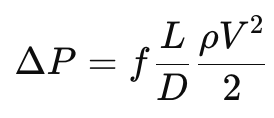Pipe Pressure Drop Calculator
Blog post description.
Wiratama
11/15/20251 min read
Pipe Pressure Drop – Definition
Pipe pressure drop is the loss of pressure that occurs as a fluid flows through a pipe. This pressure reduction results from friction between the fluid and the pipe walls, as well as internal fluid turbulence. Understanding pressure drop is essential for designing piping systems, pump sizing, HVAC ducts, and industrial flow networks.
Background Theory
The most widely used model for head loss in pipe flow is the Darcy–Weisbach equation:


Where:
ΔP = pressure drop (Pa)
f = friction factor (depends on flow regime & roughness)
L = pipe length (m)
D = pipe diameter (m)
ρ = fluid density (kg/m³)
V = flow velocity (m/s)
The friction factor f is influenced by:
Flow regime (laminar or turbulent)
Pipe roughness
Reynolds number
Fluid properties
In laminar flow, friction factor is predictable. In turbulent flow, it must be found from the Moody chart or equations such as Colebrook–White.
This calculator uses a user-supplied friction factor, allowing flexibility for different pipe materials, flow conditions, and fluids.
How This Calculator Works
This calculator estimates pressure drop through a pipe by:
Asking for key parameters:
friction factor, pipe length, diameter, fluid density, and velocityApplying the Darcy–Weisbach equation
Computing and displaying the pressure drop instantly in Pascals (Pa)
The tool provides a fast and reliable way to evaluate pressure losses for pipe flow design—useful for engineers working in mechanical, chemical, process, HVAC, and fluid transport systems.
